NURS2003 Case Study Assignment: Analyzing Toan Le's Life Span
VerifiedAdded on 2022/09/29
|18
|4600
|31
Case Study
AI Summary
This case study presents a comprehensive analysis of Toan Le's life span, focusing on biological, psychological, and social factors influencing his development. The study, conducted for a Bachelor of Nursing assignment (NURS2003), involved an interview with Toan Le, a 69-year-old Australian of Indigenous origin, and observations of his life. The analysis explores his family history of diabetes, his psychological well-being, and the social factors impacting his life, including cultural influences and financial stability. The paper examines how Toan Le has managed his chronic diabetes and adapted his lifestyle, including his work, diet, and social interactions. It also considers his family dynamics and support system, predicting his health trajectory over the next five years. The assignment includes appendices with summaries of observations and questionnaires.

Running head: BACHELOR OF NURSING ASSIGNMENT 1
Bachelor of Nursing Assignment
Student’s Name
Student Number
Emai Address
Course/School
Unit
Lecturer/Tutor
Date Due
Bachelor of Nursing Assignment
Student’s Name
Student Number
Emai Address
Course/School
Unit
Lecturer/Tutor
Date Due
Paraphrase This Document
Need a fresh take? Get an instant paraphrase of this document with our AI Paraphraser
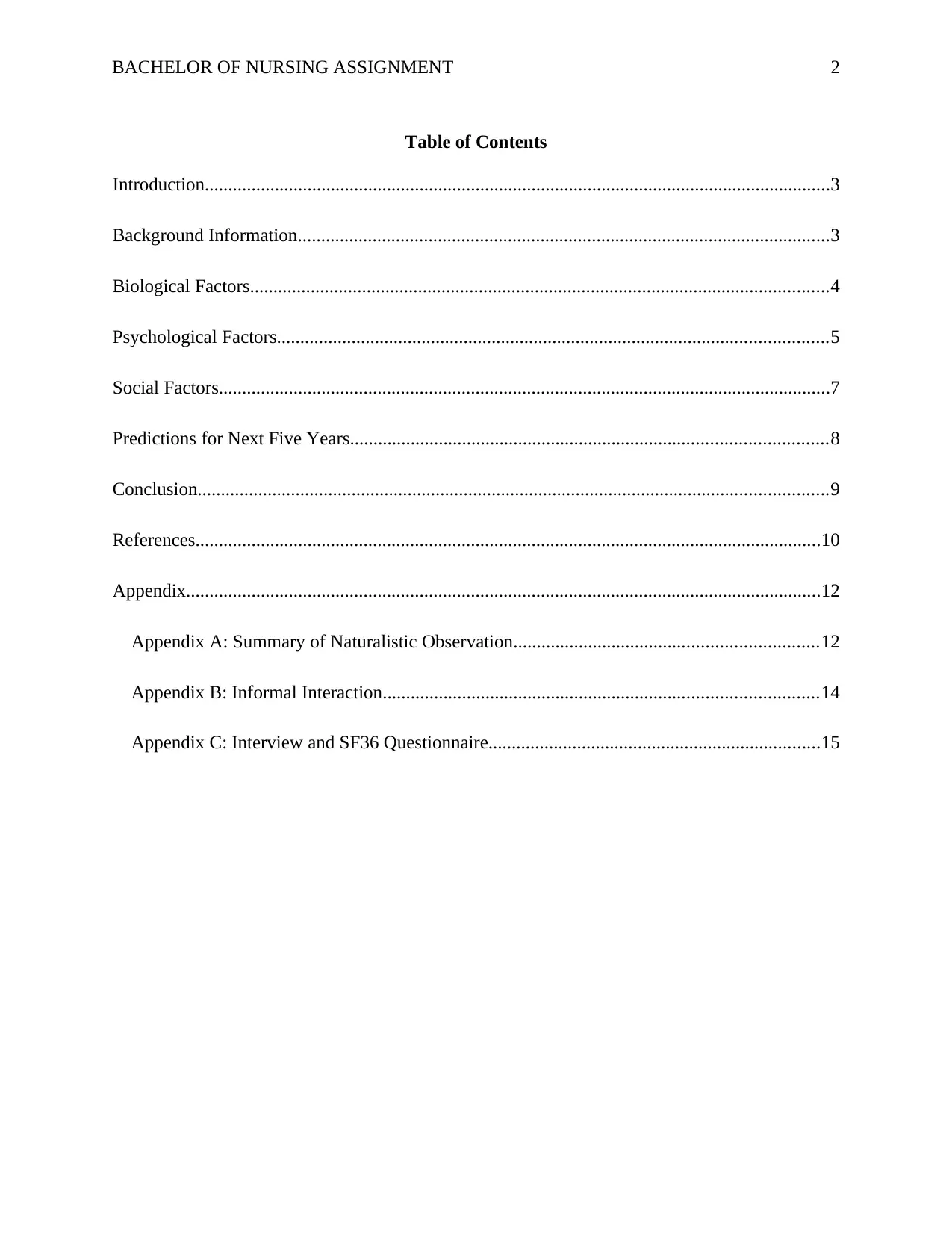
BACHELOR OF NURSING ASSIGNMENT 2
Table of Contents
Introduction......................................................................................................................................3
Background Information..................................................................................................................3
Biological Factors............................................................................................................................4
Psychological Factors......................................................................................................................5
Social Factors...................................................................................................................................7
Predictions for Next Five Years......................................................................................................8
Conclusion.......................................................................................................................................9
References......................................................................................................................................10
Appendix........................................................................................................................................12
Appendix A: Summary of Naturalistic Observation.................................................................12
Appendix B: Informal Interaction.............................................................................................14
Appendix C: Interview and SF36 Questionnaire.......................................................................15
Table of Contents
Introduction......................................................................................................................................3
Background Information..................................................................................................................3
Biological Factors............................................................................................................................4
Psychological Factors......................................................................................................................5
Social Factors...................................................................................................................................7
Predictions for Next Five Years......................................................................................................8
Conclusion.......................................................................................................................................9
References......................................................................................................................................10
Appendix........................................................................................................................................12
Appendix A: Summary of Naturalistic Observation.................................................................12
Appendix B: Informal Interaction.............................................................................................14
Appendix C: Interview and SF36 Questionnaire.......................................................................15
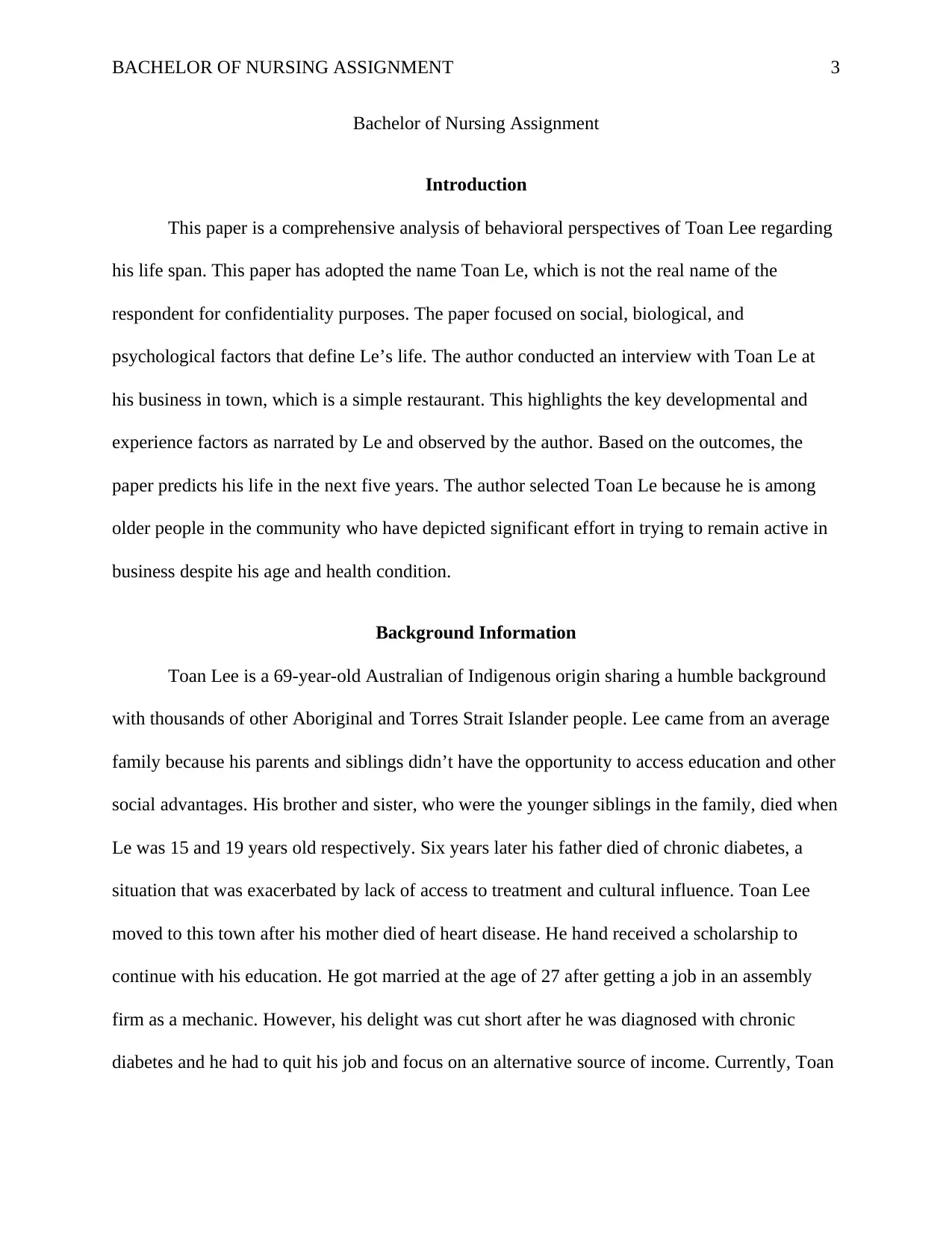
BACHELOR OF NURSING ASSIGNMENT 3
Bachelor of Nursing Assignment
Introduction
This paper is a comprehensive analysis of behavioral perspectives of Toan Lee regarding
his life span. This paper has adopted the name Toan Le, which is not the real name of the
respondent for confidentiality purposes. The paper focused on social, biological, and
psychological factors that define Le’s life. The author conducted an interview with Toan Le at
his business in town, which is a simple restaurant. This highlights the key developmental and
experience factors as narrated by Le and observed by the author. Based on the outcomes, the
paper predicts his life in the next five years. The author selected Toan Le because he is among
older people in the community who have depicted significant effort in trying to remain active in
business despite his age and health condition.
Background Information
Toan Lee is a 69-year-old Australian of Indigenous origin sharing a humble background
with thousands of other Aboriginal and Torres Strait Islander people. Lee came from an average
family because his parents and siblings didn’t have the opportunity to access education and other
social advantages. His brother and sister, who were the younger siblings in the family, died when
Le was 15 and 19 years old respectively. Six years later his father died of chronic diabetes, a
situation that was exacerbated by lack of access to treatment and cultural influence. Toan Lee
moved to this town after his mother died of heart disease. He hand received a scholarship to
continue with his education. He got married at the age of 27 after getting a job in an assembly
firm as a mechanic. However, his delight was cut short after he was diagnosed with chronic
diabetes and he had to quit his job and focus on an alternative source of income. Currently, Toan
Bachelor of Nursing Assignment
Introduction
This paper is a comprehensive analysis of behavioral perspectives of Toan Lee regarding
his life span. This paper has adopted the name Toan Le, which is not the real name of the
respondent for confidentiality purposes. The paper focused on social, biological, and
psychological factors that define Le’s life. The author conducted an interview with Toan Le at
his business in town, which is a simple restaurant. This highlights the key developmental and
experience factors as narrated by Le and observed by the author. Based on the outcomes, the
paper predicts his life in the next five years. The author selected Toan Le because he is among
older people in the community who have depicted significant effort in trying to remain active in
business despite his age and health condition.
Background Information
Toan Lee is a 69-year-old Australian of Indigenous origin sharing a humble background
with thousands of other Aboriginal and Torres Strait Islander people. Lee came from an average
family because his parents and siblings didn’t have the opportunity to access education and other
social advantages. His brother and sister, who were the younger siblings in the family, died when
Le was 15 and 19 years old respectively. Six years later his father died of chronic diabetes, a
situation that was exacerbated by lack of access to treatment and cultural influence. Toan Lee
moved to this town after his mother died of heart disease. He hand received a scholarship to
continue with his education. He got married at the age of 27 after getting a job in an assembly
firm as a mechanic. However, his delight was cut short after he was diagnosed with chronic
diabetes and he had to quit his job and focus on an alternative source of income. Currently, Toan
⊘ This is a preview!⊘
Do you want full access?
Subscribe today to unlock all pages.

Trusted by 1+ million students worldwide
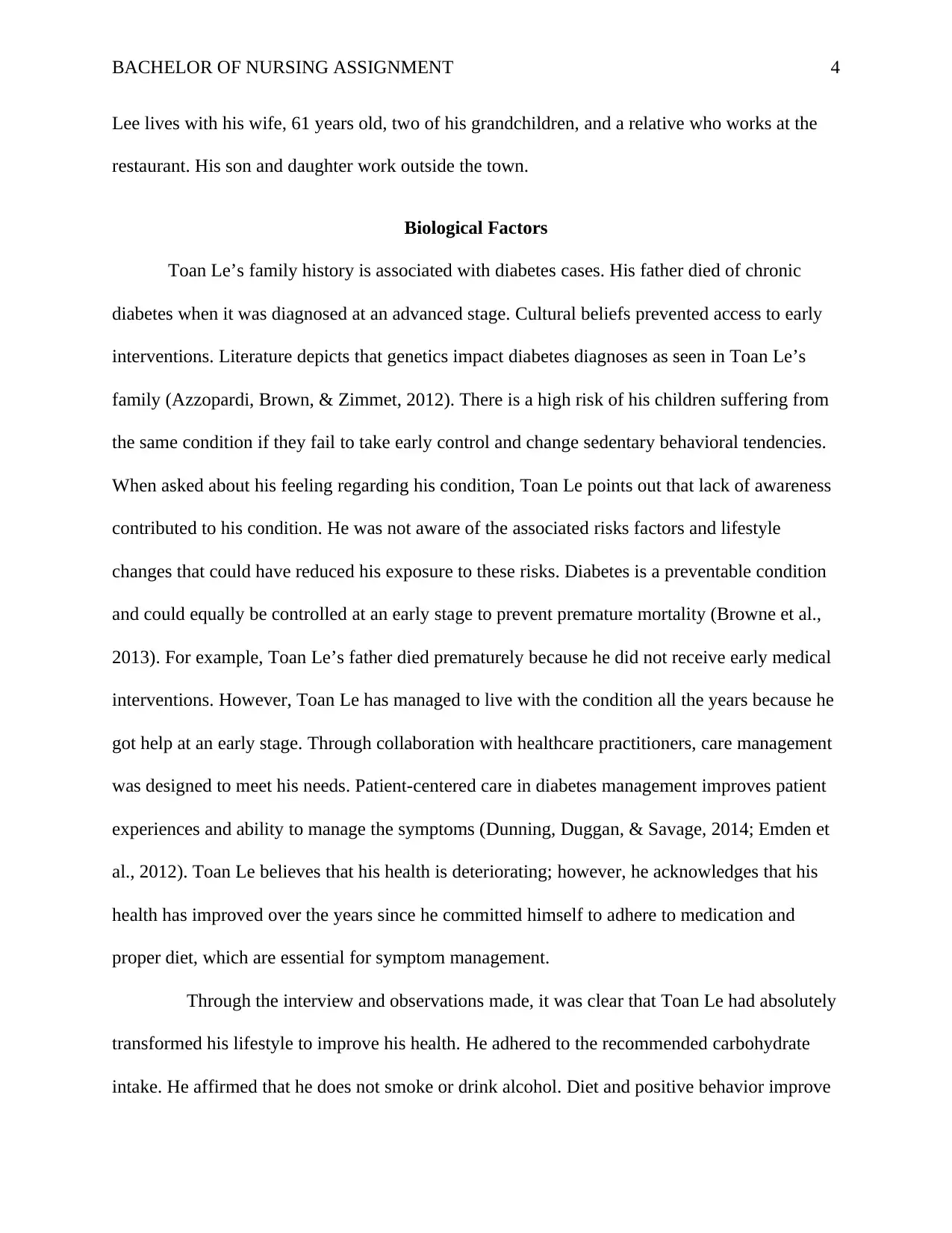
BACHELOR OF NURSING ASSIGNMENT 4
Lee lives with his wife, 61 years old, two of his grandchildren, and a relative who works at the
restaurant. His son and daughter work outside the town.
Biological Factors
Toan Le’s family history is associated with diabetes cases. His father died of chronic
diabetes when it was diagnosed at an advanced stage. Cultural beliefs prevented access to early
interventions. Literature depicts that genetics impact diabetes diagnoses as seen in Toan Le’s
family (Azzopardi, Brown, & Zimmet, 2012). There is a high risk of his children suffering from
the same condition if they fail to take early control and change sedentary behavioral tendencies.
When asked about his feeling regarding his condition, Toan Le points out that lack of awareness
contributed to his condition. He was not aware of the associated risks factors and lifestyle
changes that could have reduced his exposure to these risks. Diabetes is a preventable condition
and could equally be controlled at an early stage to prevent premature mortality (Browne et al.,
2013). For example, Toan Le’s father died prematurely because he did not receive early medical
interventions. However, Toan Le has managed to live with the condition all the years because he
got help at an early stage. Through collaboration with healthcare practitioners, care management
was designed to meet his needs. Patient-centered care in diabetes management improves patient
experiences and ability to manage the symptoms (Dunning, Duggan, & Savage, 2014; Emden et
al., 2012). Toan Le believes that his health is deteriorating; however, he acknowledges that his
health has improved over the years since he committed himself to adhere to medication and
proper diet, which are essential for symptom management.
Through the interview and observations made, it was clear that Toan Le had absolutely
transformed his lifestyle to improve his health. He adhered to the recommended carbohydrate
intake. He affirmed that he does not smoke or drink alcohol. Diet and positive behavior improve
Lee lives with his wife, 61 years old, two of his grandchildren, and a relative who works at the
restaurant. His son and daughter work outside the town.
Biological Factors
Toan Le’s family history is associated with diabetes cases. His father died of chronic
diabetes when it was diagnosed at an advanced stage. Cultural beliefs prevented access to early
interventions. Literature depicts that genetics impact diabetes diagnoses as seen in Toan Le’s
family (Azzopardi, Brown, & Zimmet, 2012). There is a high risk of his children suffering from
the same condition if they fail to take early control and change sedentary behavioral tendencies.
When asked about his feeling regarding his condition, Toan Le points out that lack of awareness
contributed to his condition. He was not aware of the associated risks factors and lifestyle
changes that could have reduced his exposure to these risks. Diabetes is a preventable condition
and could equally be controlled at an early stage to prevent premature mortality (Browne et al.,
2013). For example, Toan Le’s father died prematurely because he did not receive early medical
interventions. However, Toan Le has managed to live with the condition all the years because he
got help at an early stage. Through collaboration with healthcare practitioners, care management
was designed to meet his needs. Patient-centered care in diabetes management improves patient
experiences and ability to manage the symptoms (Dunning, Duggan, & Savage, 2014; Emden et
al., 2012). Toan Le believes that his health is deteriorating; however, he acknowledges that his
health has improved over the years since he committed himself to adhere to medication and
proper diet, which are essential for symptom management.
Through the interview and observations made, it was clear that Toan Le had absolutely
transformed his lifestyle to improve his health. He adhered to the recommended carbohydrate
intake. He affirmed that he does not smoke or drink alcohol. Diet and positive behavior improve
Paraphrase This Document
Need a fresh take? Get an instant paraphrase of this document with our AI Paraphraser
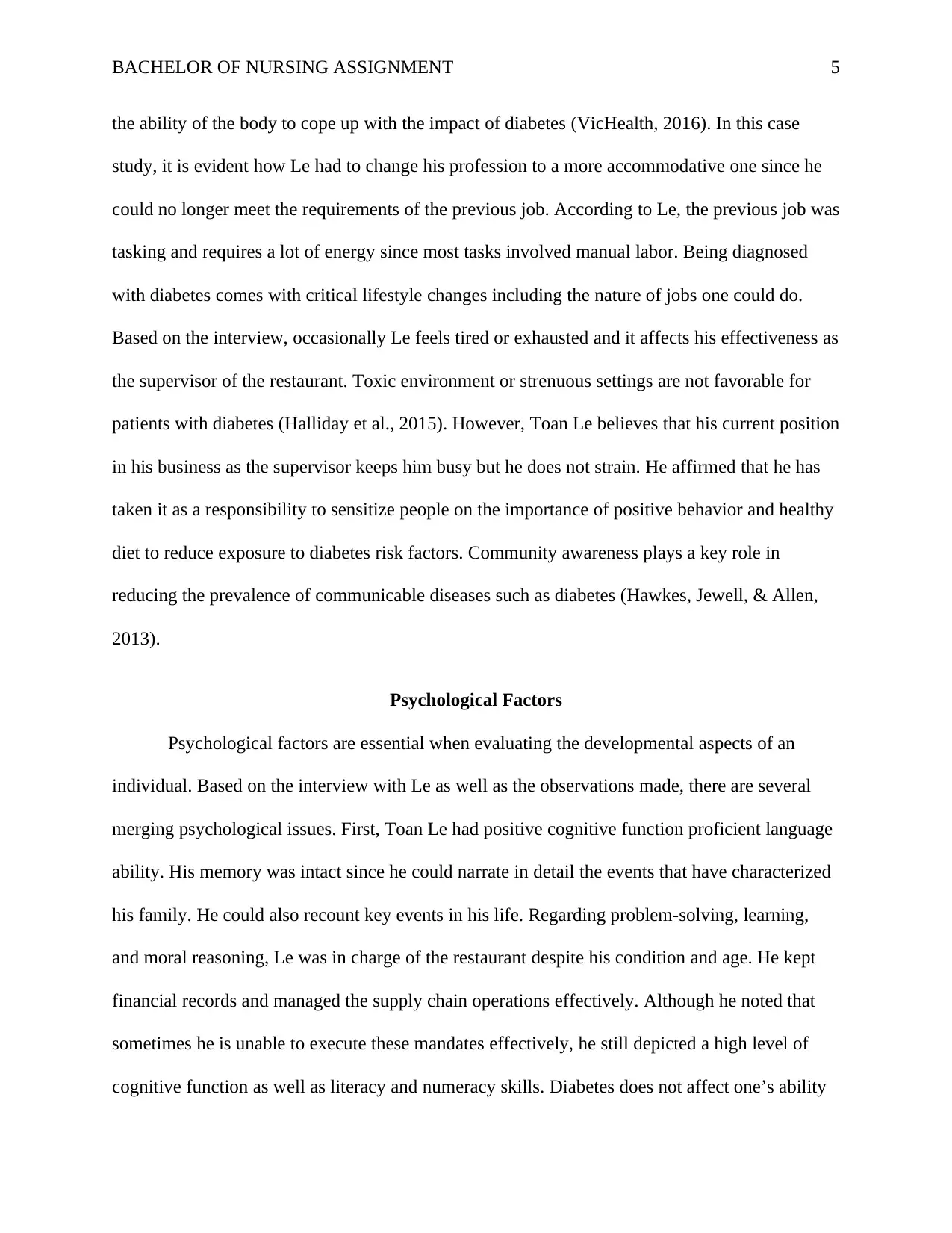
BACHELOR OF NURSING ASSIGNMENT 5
the ability of the body to cope up with the impact of diabetes (VicHealth, 2016). In this case
study, it is evident how Le had to change his profession to a more accommodative one since he
could no longer meet the requirements of the previous job. According to Le, the previous job was
tasking and requires a lot of energy since most tasks involved manual labor. Being diagnosed
with diabetes comes with critical lifestyle changes including the nature of jobs one could do.
Based on the interview, occasionally Le feels tired or exhausted and it affects his effectiveness as
the supervisor of the restaurant. Toxic environment or strenuous settings are not favorable for
patients with diabetes (Halliday et al., 2015). However, Toan Le believes that his current position
in his business as the supervisor keeps him busy but he does not strain. He affirmed that he has
taken it as a responsibility to sensitize people on the importance of positive behavior and healthy
diet to reduce exposure to diabetes risk factors. Community awareness plays a key role in
reducing the prevalence of communicable diseases such as diabetes (Hawkes, Jewell, & Allen,
2013).
Psychological Factors
Psychological factors are essential when evaluating the developmental aspects of an
individual. Based on the interview with Le as well as the observations made, there are several
merging psychological issues. First, Toan Le had positive cognitive function proficient language
ability. His memory was intact since he could narrate in detail the events that have characterized
his family. He could also recount key events in his life. Regarding problem-solving, learning,
and moral reasoning, Le was in charge of the restaurant despite his condition and age. He kept
financial records and managed the supply chain operations effectively. Although he noted that
sometimes he is unable to execute these mandates effectively, he still depicted a high level of
cognitive function as well as literacy and numeracy skills. Diabetes does not affect one’s ability
the ability of the body to cope up with the impact of diabetes (VicHealth, 2016). In this case
study, it is evident how Le had to change his profession to a more accommodative one since he
could no longer meet the requirements of the previous job. According to Le, the previous job was
tasking and requires a lot of energy since most tasks involved manual labor. Being diagnosed
with diabetes comes with critical lifestyle changes including the nature of jobs one could do.
Based on the interview, occasionally Le feels tired or exhausted and it affects his effectiveness as
the supervisor of the restaurant. Toxic environment or strenuous settings are not favorable for
patients with diabetes (Halliday et al., 2015). However, Toan Le believes that his current position
in his business as the supervisor keeps him busy but he does not strain. He affirmed that he has
taken it as a responsibility to sensitize people on the importance of positive behavior and healthy
diet to reduce exposure to diabetes risk factors. Community awareness plays a key role in
reducing the prevalence of communicable diseases such as diabetes (Hawkes, Jewell, & Allen,
2013).
Psychological Factors
Psychological factors are essential when evaluating the developmental aspects of an
individual. Based on the interview with Le as well as the observations made, there are several
merging psychological issues. First, Toan Le had positive cognitive function proficient language
ability. His memory was intact since he could narrate in detail the events that have characterized
his family. He could also recount key events in his life. Regarding problem-solving, learning,
and moral reasoning, Le was in charge of the restaurant despite his condition and age. He kept
financial records and managed the supply chain operations effectively. Although he noted that
sometimes he is unable to execute these mandates effectively, he still depicted a high level of
cognitive function as well as literacy and numeracy skills. Diabetes does not affect one’s ability
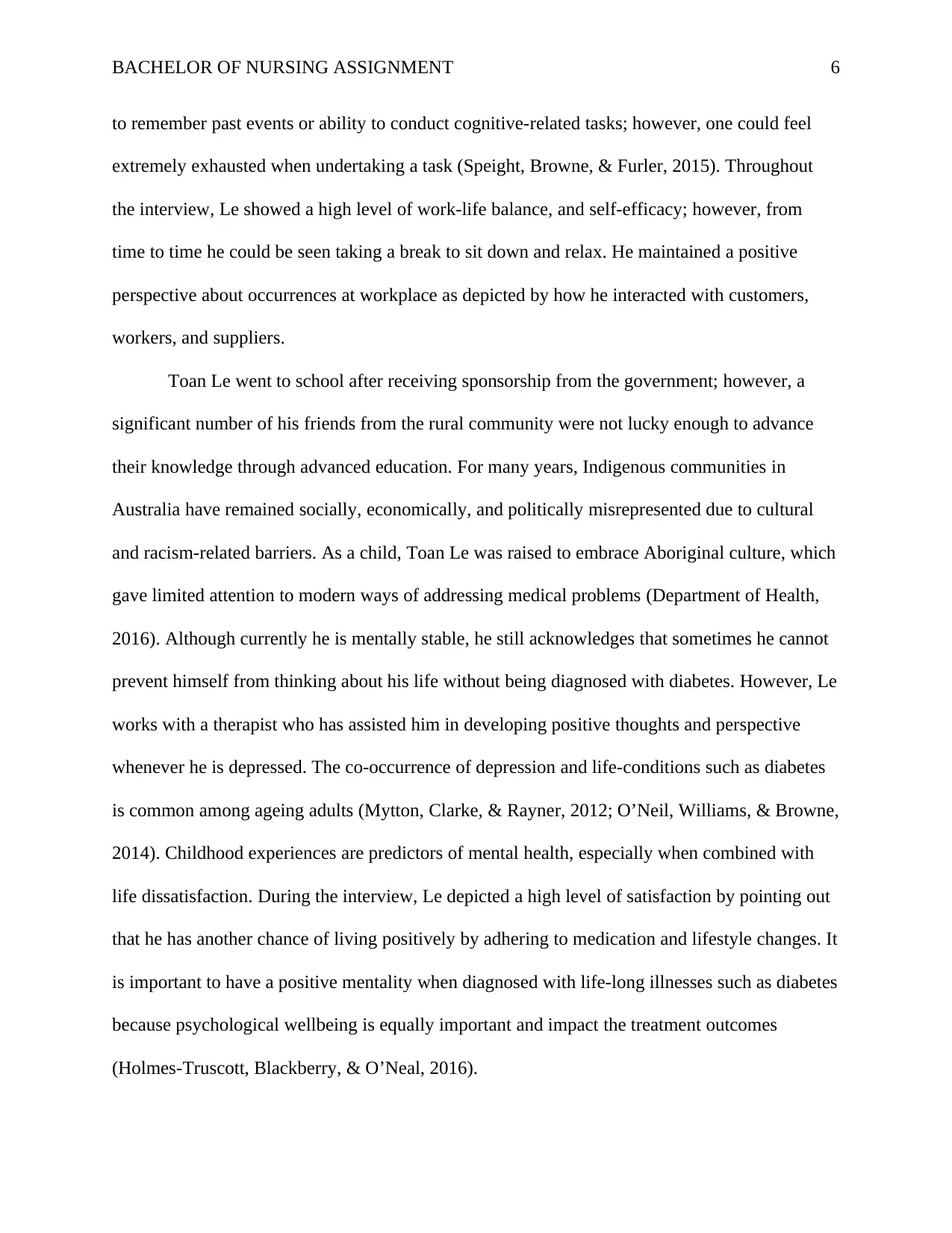
BACHELOR OF NURSING ASSIGNMENT 6
to remember past events or ability to conduct cognitive-related tasks; however, one could feel
extremely exhausted when undertaking a task (Speight, Browne, & Furler, 2015). Throughout
the interview, Le showed a high level of work-life balance, and self-efficacy; however, from
time to time he could be seen taking a break to sit down and relax. He maintained a positive
perspective about occurrences at workplace as depicted by how he interacted with customers,
workers, and suppliers.
Toan Le went to school after receiving sponsorship from the government; however, a
significant number of his friends from the rural community were not lucky enough to advance
their knowledge through advanced education. For many years, Indigenous communities in
Australia have remained socially, economically, and politically misrepresented due to cultural
and racism-related barriers. As a child, Toan Le was raised to embrace Aboriginal culture, which
gave limited attention to modern ways of addressing medical problems (Department of Health,
2016). Although currently he is mentally stable, he still acknowledges that sometimes he cannot
prevent himself from thinking about his life without being diagnosed with diabetes. However, Le
works with a therapist who has assisted him in developing positive thoughts and perspective
whenever he is depressed. The co-occurrence of depression and life-conditions such as diabetes
is common among ageing adults (Mytton, Clarke, & Rayner, 2012; O’Neil, Williams, & Browne,
2014). Childhood experiences are predictors of mental health, especially when combined with
life dissatisfaction. During the interview, Le depicted a high level of satisfaction by pointing out
that he has another chance of living positively by adhering to medication and lifestyle changes. It
is important to have a positive mentality when diagnosed with life-long illnesses such as diabetes
because psychological wellbeing is equally important and impact the treatment outcomes
(Holmes-Truscott, Blackberry, & O’Neal, 2016).
to remember past events or ability to conduct cognitive-related tasks; however, one could feel
extremely exhausted when undertaking a task (Speight, Browne, & Furler, 2015). Throughout
the interview, Le showed a high level of work-life balance, and self-efficacy; however, from
time to time he could be seen taking a break to sit down and relax. He maintained a positive
perspective about occurrences at workplace as depicted by how he interacted with customers,
workers, and suppliers.
Toan Le went to school after receiving sponsorship from the government; however, a
significant number of his friends from the rural community were not lucky enough to advance
their knowledge through advanced education. For many years, Indigenous communities in
Australia have remained socially, economically, and politically misrepresented due to cultural
and racism-related barriers. As a child, Toan Le was raised to embrace Aboriginal culture, which
gave limited attention to modern ways of addressing medical problems (Department of Health,
2016). Although currently he is mentally stable, he still acknowledges that sometimes he cannot
prevent himself from thinking about his life without being diagnosed with diabetes. However, Le
works with a therapist who has assisted him in developing positive thoughts and perspective
whenever he is depressed. The co-occurrence of depression and life-conditions such as diabetes
is common among ageing adults (Mytton, Clarke, & Rayner, 2012; O’Neil, Williams, & Browne,
2014). Childhood experiences are predictors of mental health, especially when combined with
life dissatisfaction. During the interview, Le depicted a high level of satisfaction by pointing out
that he has another chance of living positively by adhering to medication and lifestyle changes. It
is important to have a positive mentality when diagnosed with life-long illnesses such as diabetes
because psychological wellbeing is equally important and impact the treatment outcomes
(Holmes-Truscott, Blackberry, & O’Neal, 2016).
⊘ This is a preview!⊘
Do you want full access?
Subscribe today to unlock all pages.

Trusted by 1+ million students worldwide

BACHELOR OF NURSING ASSIGNMENT 7
Social Factors
Family demographics could define health patterns characterizing an individual. When it
comes to diabetes, genetic factors play a significant role in family diagnosis. Toan Le came from
a family where diabetes was prevalent. The father and mother died from health complications
due to delayed diagnosis owing to the cultural background. Coming from Indigenous background
implied that he was already at risk of several health complications due to cultural practice as well
as lifestyle factors. The limited awareness that dominated Indigenous communities in the past
years contributed to increased mortality caused by non-communicable and communicable
diseases (Diabetes Australia, 2014). However, with increased focused state interventions,
Indigenous communities have improved in terms of wellbeing. The interview with Toan Le
showed that initially his family was not stable financially; however, he can currently cater to his
basic needs. His two children have gone to school and are currently pursuing higher education.
Financial stability is an essential factor that determines the outcome of health diagnoses. When a
family is not financially stable, they cannot afford long-term medication for diseases such as
diabetes. However, for Le, the restaurant is generating sustainable income that meets his
financial needs.
Toan Le revealed how the family has played a key role in enhancing a balanced
psychosocial environment. His wife and children have been supporting emotionally and
financially to establish a plan that caters to the family’s medical needs. Being diagnosed with a
life-long condition affects not only the individual but also the close family. Effective recovery
depends on multidimensional factors such as the extent to which the family is willing and able to
offer emotional and financial support when needed. According to clinical evidence, collaboration
between practitioners, the patient, and the family enhances the effectiveness of care management
Social Factors
Family demographics could define health patterns characterizing an individual. When it
comes to diabetes, genetic factors play a significant role in family diagnosis. Toan Le came from
a family where diabetes was prevalent. The father and mother died from health complications
due to delayed diagnosis owing to the cultural background. Coming from Indigenous background
implied that he was already at risk of several health complications due to cultural practice as well
as lifestyle factors. The limited awareness that dominated Indigenous communities in the past
years contributed to increased mortality caused by non-communicable and communicable
diseases (Diabetes Australia, 2014). However, with increased focused state interventions,
Indigenous communities have improved in terms of wellbeing. The interview with Toan Le
showed that initially his family was not stable financially; however, he can currently cater to his
basic needs. His two children have gone to school and are currently pursuing higher education.
Financial stability is an essential factor that determines the outcome of health diagnoses. When a
family is not financially stable, they cannot afford long-term medication for diseases such as
diabetes. However, for Le, the restaurant is generating sustainable income that meets his
financial needs.
Toan Le revealed how the family has played a key role in enhancing a balanced
psychosocial environment. His wife and children have been supporting emotionally and
financially to establish a plan that caters to the family’s medical needs. Being diagnosed with a
life-long condition affects not only the individual but also the close family. Effective recovery
depends on multidimensional factors such as the extent to which the family is willing and able to
offer emotional and financial support when needed. According to clinical evidence, collaboration
between practitioners, the patient, and the family enhances the effectiveness of care management
Paraphrase This Document
Need a fresh take? Get an instant paraphrase of this document with our AI Paraphraser
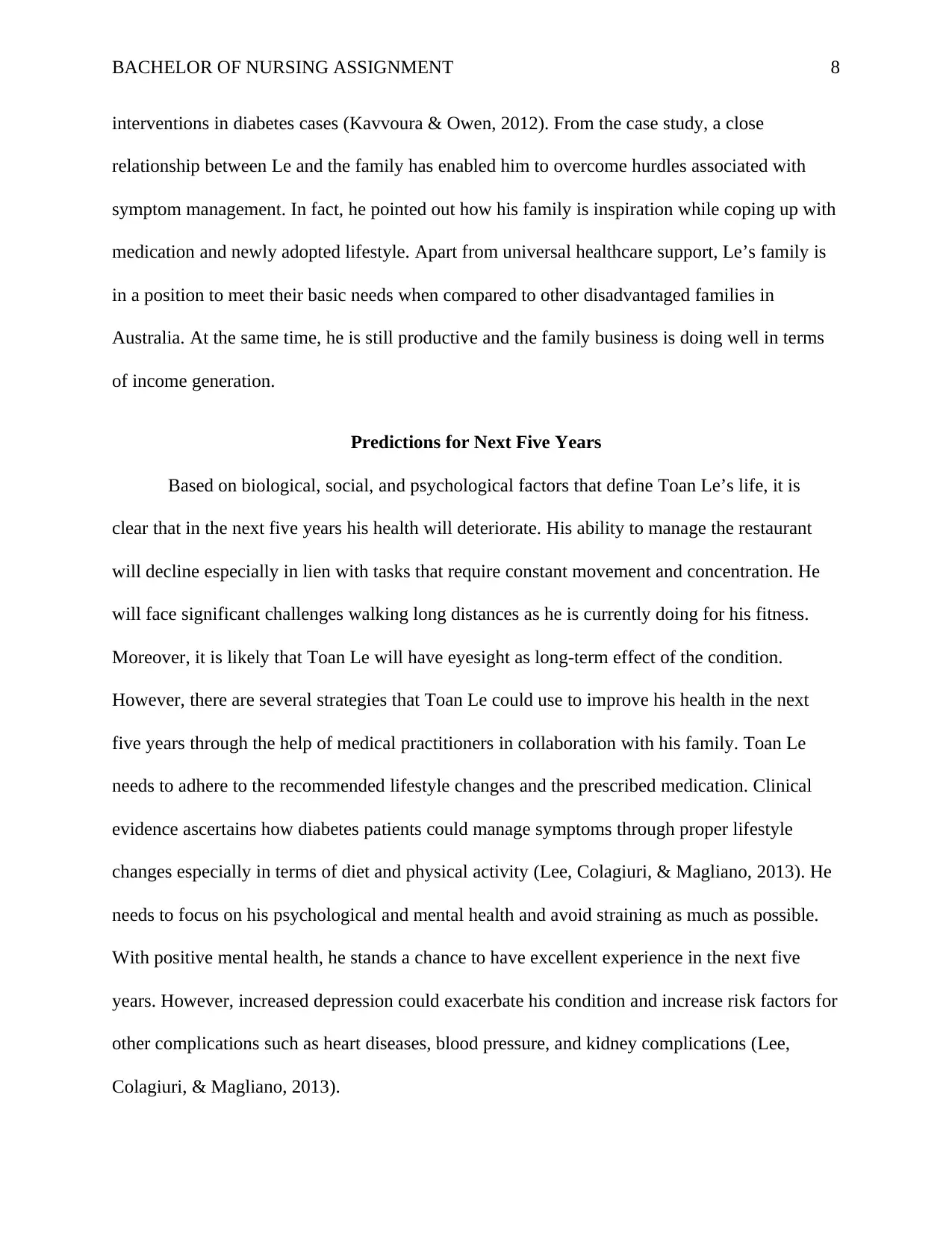
BACHELOR OF NURSING ASSIGNMENT 8
interventions in diabetes cases (Kavvoura & Owen, 2012). From the case study, a close
relationship between Le and the family has enabled him to overcome hurdles associated with
symptom management. In fact, he pointed out how his family is inspiration while coping up with
medication and newly adopted lifestyle. Apart from universal healthcare support, Le’s family is
in a position to meet their basic needs when compared to other disadvantaged families in
Australia. At the same time, he is still productive and the family business is doing well in terms
of income generation.
Predictions for Next Five Years
Based on biological, social, and psychological factors that define Toan Le’s life, it is
clear that in the next five years his health will deteriorate. His ability to manage the restaurant
will decline especially in lien with tasks that require constant movement and concentration. He
will face significant challenges walking long distances as he is currently doing for his fitness.
Moreover, it is likely that Toan Le will have eyesight as long-term effect of the condition.
However, there are several strategies that Toan Le could use to improve his health in the next
five years through the help of medical practitioners in collaboration with his family. Toan Le
needs to adhere to the recommended lifestyle changes and the prescribed medication. Clinical
evidence ascertains how diabetes patients could manage symptoms through proper lifestyle
changes especially in terms of diet and physical activity (Lee, Colagiuri, & Magliano, 2013). He
needs to focus on his psychological and mental health and avoid straining as much as possible.
With positive mental health, he stands a chance to have excellent experience in the next five
years. However, increased depression could exacerbate his condition and increase risk factors for
other complications such as heart diseases, blood pressure, and kidney complications (Lee,
Colagiuri, & Magliano, 2013).
interventions in diabetes cases (Kavvoura & Owen, 2012). From the case study, a close
relationship between Le and the family has enabled him to overcome hurdles associated with
symptom management. In fact, he pointed out how his family is inspiration while coping up with
medication and newly adopted lifestyle. Apart from universal healthcare support, Le’s family is
in a position to meet their basic needs when compared to other disadvantaged families in
Australia. At the same time, he is still productive and the family business is doing well in terms
of income generation.
Predictions for Next Five Years
Based on biological, social, and psychological factors that define Toan Le’s life, it is
clear that in the next five years his health will deteriorate. His ability to manage the restaurant
will decline especially in lien with tasks that require constant movement and concentration. He
will face significant challenges walking long distances as he is currently doing for his fitness.
Moreover, it is likely that Toan Le will have eyesight as long-term effect of the condition.
However, there are several strategies that Toan Le could use to improve his health in the next
five years through the help of medical practitioners in collaboration with his family. Toan Le
needs to adhere to the recommended lifestyle changes and the prescribed medication. Clinical
evidence ascertains how diabetes patients could manage symptoms through proper lifestyle
changes especially in terms of diet and physical activity (Lee, Colagiuri, & Magliano, 2013). He
needs to focus on his psychological and mental health and avoid straining as much as possible.
With positive mental health, he stands a chance to have excellent experience in the next five
years. However, increased depression could exacerbate his condition and increase risk factors for
other complications such as heart diseases, blood pressure, and kidney complications (Lee,
Colagiuri, & Magliano, 2013).

BACHELOR OF NURSING ASSIGNMENT 9
Conclusion
In conclusion, older diabetes patients face significant challenges in life, which are
exacerbated by social and psychological factors. However, through proper care management, it is
possible to live a positive life. The major issues that such patients need to consider include
constantly maintain a healthy diet according to the meal recommended by the doctor, stick to the
medication plan, and improve their physical activity. Based on the findings of this assessment, it
is clear that a one-hour data collection session was not enough to provide comprehensive details
about Taon Le. A more diverse methodology over an extended period is needed to enhance the
validity of the case study findings.
Conclusion
In conclusion, older diabetes patients face significant challenges in life, which are
exacerbated by social and psychological factors. However, through proper care management, it is
possible to live a positive life. The major issues that such patients need to consider include
constantly maintain a healthy diet according to the meal recommended by the doctor, stick to the
medication plan, and improve their physical activity. Based on the findings of this assessment, it
is clear that a one-hour data collection session was not enough to provide comprehensive details
about Taon Le. A more diverse methodology over an extended period is needed to enhance the
validity of the case study findings.
⊘ This is a preview!⊘
Do you want full access?
Subscribe today to unlock all pages.

Trusted by 1+ million students worldwide
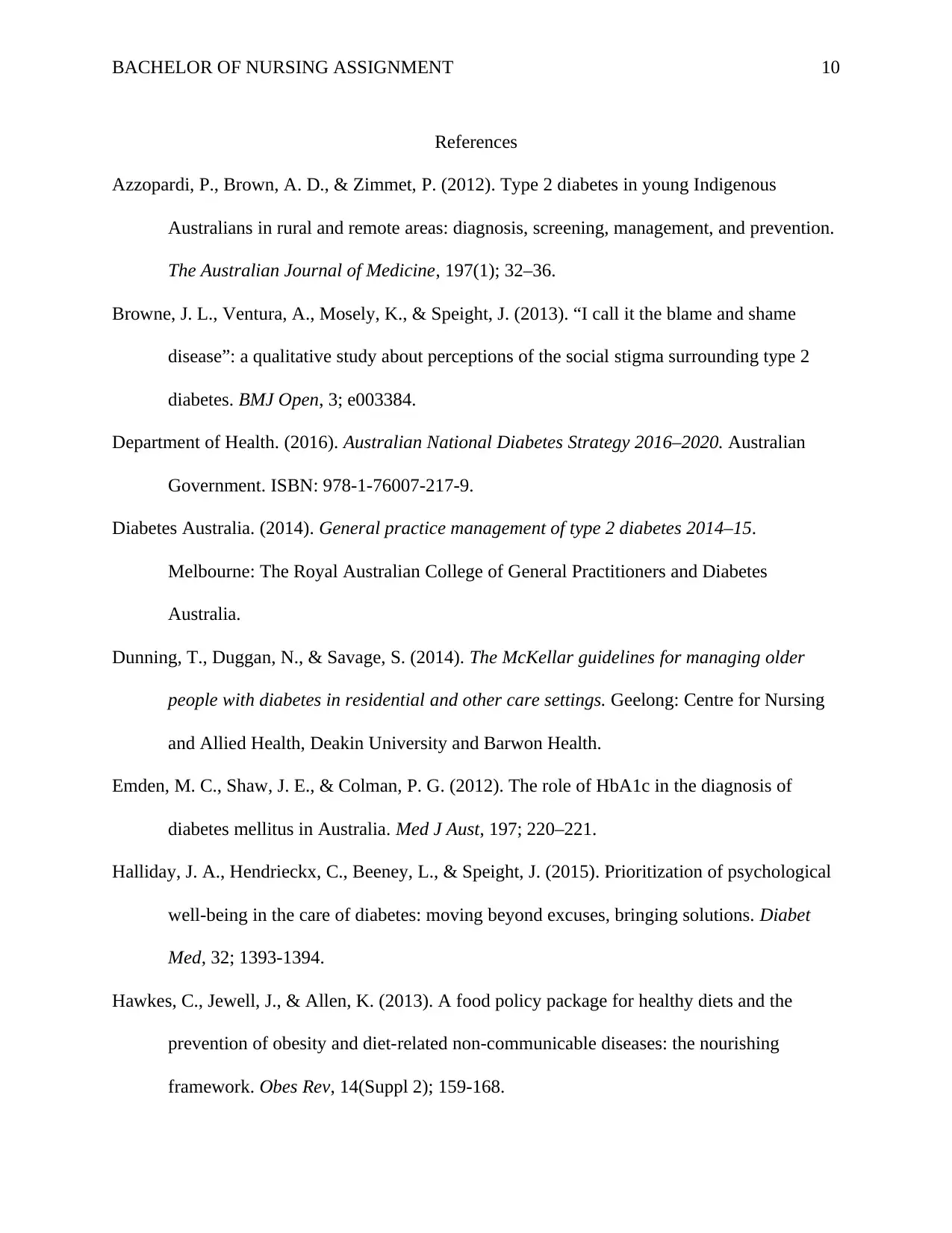
BACHELOR OF NURSING ASSIGNMENT 10
References
Azzopardi, P., Brown, A. D., & Zimmet, P. (2012). Type 2 diabetes in young Indigenous
Australians in rural and remote areas: diagnosis, screening, management, and prevention.
The Australian Journal of Medicine, 197(1); 32–36.
Browne, J. L., Ventura, A., Mosely, K., & Speight, J. (2013). “I call it the blame and shame
disease”: a qualitative study about perceptions of the social stigma surrounding type 2
diabetes. BMJ Open, 3; e003384.
Department of Health. (2016). Australian National Diabetes Strategy 2016–2020. Australian
Government. ISBN: 978-1-76007-217-9.
Diabetes Australia. (2014). General practice management of type 2 diabetes 2014–15.
Melbourne: The Royal Australian College of General Practitioners and Diabetes
Australia.
Dunning, T., Duggan, N., & Savage, S. (2014). The McKellar guidelines for managing older
people with diabetes in residential and other care settings. Geelong: Centre for Nursing
and Allied Health, Deakin University and Barwon Health.
Emden, M. C., Shaw, J. E., & Colman, P. G. (2012). The role of HbA1c in the diagnosis of
diabetes mellitus in Australia. Med J Aust, 197; 220–221.
Halliday, J. A., Hendrieckx, C., Beeney, L., & Speight, J. (2015). Prioritization of psychological
well-being in the care of diabetes: moving beyond excuses, bringing solutions. Diabet
Med, 32; 1393-1394.
Hawkes, C., Jewell, J., & Allen, K. (2013). A food policy package for healthy diets and the
prevention of obesity and diet-related non-communicable diseases: the nourishing
framework. Obes Rev, 14(Suppl 2); 159-168.
References
Azzopardi, P., Brown, A. D., & Zimmet, P. (2012). Type 2 diabetes in young Indigenous
Australians in rural and remote areas: diagnosis, screening, management, and prevention.
The Australian Journal of Medicine, 197(1); 32–36.
Browne, J. L., Ventura, A., Mosely, K., & Speight, J. (2013). “I call it the blame and shame
disease”: a qualitative study about perceptions of the social stigma surrounding type 2
diabetes. BMJ Open, 3; e003384.
Department of Health. (2016). Australian National Diabetes Strategy 2016–2020. Australian
Government. ISBN: 978-1-76007-217-9.
Diabetes Australia. (2014). General practice management of type 2 diabetes 2014–15.
Melbourne: The Royal Australian College of General Practitioners and Diabetes
Australia.
Dunning, T., Duggan, N., & Savage, S. (2014). The McKellar guidelines for managing older
people with diabetes in residential and other care settings. Geelong: Centre for Nursing
and Allied Health, Deakin University and Barwon Health.
Emden, M. C., Shaw, J. E., & Colman, P. G. (2012). The role of HbA1c in the diagnosis of
diabetes mellitus in Australia. Med J Aust, 197; 220–221.
Halliday, J. A., Hendrieckx, C., Beeney, L., & Speight, J. (2015). Prioritization of psychological
well-being in the care of diabetes: moving beyond excuses, bringing solutions. Diabet
Med, 32; 1393-1394.
Hawkes, C., Jewell, J., & Allen, K. (2013). A food policy package for healthy diets and the
prevention of obesity and diet-related non-communicable diseases: the nourishing
framework. Obes Rev, 14(Suppl 2); 159-168.
Paraphrase This Document
Need a fresh take? Get an instant paraphrase of this document with our AI Paraphraser

BACHELOR OF NURSING ASSIGNMENT 11
Holmes-Truscott, E., Blackberry, I., & O’Neal, D. N. (2016). Willingness to initiate insulin
among adults with type 2 diabetes in Australian primary care: results from the Stepping
Up Study. Diabetes Res Clin Pract, 114; 126-135.
Kavvoura, F. K. & Owen K. R. (2012). Maturity onset diabetes of the young: clinical
characteristics, diagnosis, and management. Pediatr Endocrinol Rev, 10; 234–242.
Lee, C., Colagiuri, R., & Magliano, D. (2013). The cost of diabetes in adults in Australia.
Diabetes Research and Clinical Practice, 99; 385–390.
Mytton, O. T., Clarke, D., & Rayner, M. (2012). Taxing unhealthy food and drinks to improve
health. BMJ, 344; e2931.
O’Neil, A., Williams, E., & Browne, J. L. (2014). Associations between economic hardship,
employment status and markers of self-management in adults with type 2 diabetes: results
from Diabetes MILES — Australia. Aust N Z J Public Health, 38; 466-472.
Skinner, T. C. (2014). Can awareness of the actual risk of complications improve outcomes in
adults with type 2 diabetes? Findings of a pilot study. J Nurs Care, 3.
Speight, J., Browne, J. L., & Furler, J. S. (2015). Testing times! Choosing wisely when it comes
to monitoring type-2 diabetes. MJA, 203; 354-356.
VicHealth. (2016). Behavioral insights and healthier lives. Melbourne: Victorian Health
Promotion Foundation.
Holmes-Truscott, E., Blackberry, I., & O’Neal, D. N. (2016). Willingness to initiate insulin
among adults with type 2 diabetes in Australian primary care: results from the Stepping
Up Study. Diabetes Res Clin Pract, 114; 126-135.
Kavvoura, F. K. & Owen K. R. (2012). Maturity onset diabetes of the young: clinical
characteristics, diagnosis, and management. Pediatr Endocrinol Rev, 10; 234–242.
Lee, C., Colagiuri, R., & Magliano, D. (2013). The cost of diabetes in adults in Australia.
Diabetes Research and Clinical Practice, 99; 385–390.
Mytton, O. T., Clarke, D., & Rayner, M. (2012). Taxing unhealthy food and drinks to improve
health. BMJ, 344; e2931.
O’Neil, A., Williams, E., & Browne, J. L. (2014). Associations between economic hardship,
employment status and markers of self-management in adults with type 2 diabetes: results
from Diabetes MILES — Australia. Aust N Z J Public Health, 38; 466-472.
Skinner, T. C. (2014). Can awareness of the actual risk of complications improve outcomes in
adults with type 2 diabetes? Findings of a pilot study. J Nurs Care, 3.
Speight, J., Browne, J. L., & Furler, J. S. (2015). Testing times! Choosing wisely when it comes
to monitoring type-2 diabetes. MJA, 203; 354-356.
VicHealth. (2016). Behavioral insights and healthier lives. Melbourne: Victorian Health
Promotion Foundation.

BACHELOR OF NURSING ASSIGNMENT 12
Appendix
Appendix A: Summary of Naturalistic Observation
Toan Le is a business person who owns a restaurant in town. He works with the other 11
employees; however, he is majorly concerned with supervision and financial management. The
other chef-related jobs are shared among the remaining workers according to a duty schedule.
The employees work together as a team with a focus on customer satisfaction. They work in
coordination. Some are restricted to the customer service area, one on the counter while the rest
work in the kitchen. Toan Lee is seen moving across all the sections of the restaurant, which is
common with supervision roles.
No
.
Activity Description Number of
Minutes
Undertaken
Percentage
(out of 60
min)
1 Making a phone
call to suppliers
Toan Le made two calls to people he was
asking about the supplies they were to make.
Based on the conversation, it was a follow up
on what they had discussed the previous day.
7 12
2 Receiving Supplies When supplies arrived Toan Le came with a
book and recorded the food products as the
workers took them to the store.
10 17
3 Inspecting the
Kitchen
Toan Le went to the kitchen and checked how
the chefs were doing their work. He also
inspected the level of cleanliness.
2 3
4 Formal
conversation with a
co-worker
After inspecting the kitchen Toan Le made a
few remarks to the senior chef relating to the
status of the kitchen.
2 3
5 Informal
conversation with
co-workers
Toan Le made a few jokes with the workers in
the kitchen before leaving to talk with the
suppliers who were still taking coffee on the
other side of the eatery.
2 3
6 Making payment to
suppliers
Toan Le made the payments for that day to
the suppliers and made a schedule for
tomorrow's deliveries.
4 6
7 Checking the
customer section
Toan Le moves across the customer section of
the restaurant while checking the tables, seats,
and the floor.
2 3
Appendix
Appendix A: Summary of Naturalistic Observation
Toan Le is a business person who owns a restaurant in town. He works with the other 11
employees; however, he is majorly concerned with supervision and financial management. The
other chef-related jobs are shared among the remaining workers according to a duty schedule.
The employees work together as a team with a focus on customer satisfaction. They work in
coordination. Some are restricted to the customer service area, one on the counter while the rest
work in the kitchen. Toan Lee is seen moving across all the sections of the restaurant, which is
common with supervision roles.
No
.
Activity Description Number of
Minutes
Undertaken
Percentage
(out of 60
min)
1 Making a phone
call to suppliers
Toan Le made two calls to people he was
asking about the supplies they were to make.
Based on the conversation, it was a follow up
on what they had discussed the previous day.
7 12
2 Receiving Supplies When supplies arrived Toan Le came with a
book and recorded the food products as the
workers took them to the store.
10 17
3 Inspecting the
Kitchen
Toan Le went to the kitchen and checked how
the chefs were doing their work. He also
inspected the level of cleanliness.
2 3
4 Formal
conversation with a
co-worker
After inspecting the kitchen Toan Le made a
few remarks to the senior chef relating to the
status of the kitchen.
2 3
5 Informal
conversation with
co-workers
Toan Le made a few jokes with the workers in
the kitchen before leaving to talk with the
suppliers who were still taking coffee on the
other side of the eatery.
2 3
6 Making payment to
suppliers
Toan Le made the payments for that day to
the suppliers and made a schedule for
tomorrow's deliveries.
4 6
7 Checking the
customer section
Toan Le moves across the customer section of
the restaurant while checking the tables, seats,
and the floor.
2 3
⊘ This is a preview!⊘
Do you want full access?
Subscribe today to unlock all pages.

Trusted by 1+ million students worldwide
1 out of 18
Related Documents
Your All-in-One AI-Powered Toolkit for Academic Success.
+13062052269
info@desklib.com
Available 24*7 on WhatsApp / Email
![[object Object]](/_next/static/media/star-bottom.7253800d.svg)
Unlock your academic potential
Copyright © 2020–2025 A2Z Services. All Rights Reserved. Developed and managed by ZUCOL.




